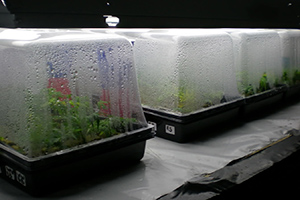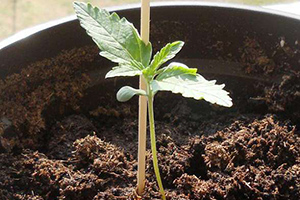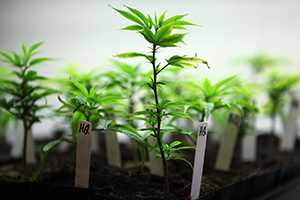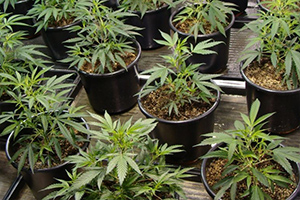Cannabis can be reproduced (propagated) sexually or asexually. Seeds are the product of sexual propagation; cuttings or clones are the result of asexual propagation. Often, both methods of cannabis propagation are used. If you have purchased some good seeds, you can germinate and grow a few of them and store the rest for use at a later date. Then after a few weeks of growth, you can determine which of the plants are the most vigorous and after a few more weeks you can start taking cuttings from the chosen plant(s) to root and populate your garden. Let’s start with seeds.




Growing from Seed
The simplest way to start seeds:
- Buy some styrofoam cups from the store and cut a drainage hole in the bottom
- Fill the styrofoam cups with an inert growing medium (do not use soil from the yard or you will bring pests into the grow room). Using inert mediums for seedlings will starve molds and mildew to death. Generally I use Pro-Mix HP or Sunshine mix. These have nothing in them that mold can grow on. When in doubt use a mix of milled sphagnum peat, vermiculite and perlite. These are inert and will not grow mold. Nutrients are your enemy when growing from seed. Don’t apply any nutrients or anything with biological activity until after the seedlings grow roots. At this point they need food, before rooting they do not.
- Plant your seeds at a depth of twice the seeds length
- Spray the surface of the soil with RO (reverse osmosis) water from a spray bottle, making sure the top 1/2 to 1 inch of soil is nice and moist (be careful not to oversaturate the soil)
- Place your cups inside a humidity dome in a warm 70° room
- Place a fluorescent light fixture of some sort above the humidity dome
- Check daily to make sure that the surface is moist and use spray bottle if necessary
- After about 3 days, if you are starting with good viable seeds, you should see the little guys peeking their way out of the soil
Once your seeds have germinated and surfaced, take good care not to overwater them. Keep the soil moist, but only use a spray bottle to moisten the soil until your seedlings have put on a few sets of leaves. It is important for the new roots to grow, over watering the soil will invite fungi and damping off will kill seedlings. Make sure that your seedlings get fresh air inside the humidity dome by opening the vents at the top and removing the cover for short durations during the first 2 weeks.
The seedling growth stage lasts about 2 to 3 weeks after seeds have germinated. Once a strong root system has been established and foliage growth increases rapidly, seedlings enter the vegetative growth stage. When properly maintained, cannabis will grow from 1/2 inch to 2 inches per day. A plant that becomes stunted at this early stage can take weeks to resume normal growth. A strong unrestricted root system is essential to supply much needed water and nutrients. Maintaining the ideal conditions during the vegetative growth stage is essential for a healthy harvest.




Making Clones
Simply put, branches cut from of a mother plant can be rooted and a new plant(s) with all of the characteristics of the mother plant can be obtained. Cannabis is a relatively easy plant to clone if given the right conditions. Before you get started you will need to have a clean sterile pair of pruners, Olivia’s Cloning Gel, styrofoam cups with a drainage hole cut out of the bottom, some good store bought potting soil, a razor blade, humidity dome, and a humidity dome heating pad.
- Set up your humidity dome and heating pad.
- Fill your styrofoam cups with an inert growing medium, push a pencil or small implement about 2 inches into the center of the soil to make the hole that you will be inserting the cutting into. Using inert mediums for cuttings will starve molds and mildew to death. Generally I use Pro-Mix HP or Sunshine mix. These have nothing in them that mold can grow on. When in doubt use a mix of milled sphagnum peat, vermiculite and perlite. These are inert and will not grow mold. Nutrients are your enemy when striking cuttings. Don’t apply any nutrients or anything with biological activity until after the cuttings grow roots. At this point they need food, before rooting they do not.
- Thoroughly spray the soil surface and into the hole until evenly moist, making sure not to over saturate the soil (remember the cuttings have no way to absorb the moisture until roots form so don’t over do it).
- Open your jar of cloning gel and stir it up a little, bring it to room temperature.
- Fill a styrofoam cup with water, grab your pruners, and head over to your mother plant.
- Take cuttings from the lower branches of your mother plant. Ideally, take cuttings of branches that have at least 2 internodes of leaves below the growing tip. Make your cut at a 45° angle just below the lower internode and place the cutting into your cup of water. Repeat until you have all of your cuttings and then return to your humidity dome and work area.
- Trim off all but a few of the leaves at the top of the cuttings.
- If the leaves on your cuttings are large, cut the leaves in half. This will lower transpiration and provide for a smoother transition.
- With your razor blade, lightly scrape away 1/2 to 1 inch of the outer layer of the stem, near the base where the cut was made.
- Place cutting in cloning gel and gently bob it up and down for 15 seconds to coat the end of the cutting with the rooting hormone.
- Place the cutting into the hole you made in the soil filled cups, and gently press the soil around the cutting to make sure that it is secure.
- Place the cup into the humidity dome and repeat for the rest of your cuttings.
- Place a fluorescent light of some sort above the humidity dome and keep it on 24 hours a day.
If over the next 3 to 4 weeks any of your cuttings start turning yellow or become pale, make sure that your light source isn’t too close to the top of the humidity dome. Cuttings need time to recover after such a traumatic experience and they will be unable to process very bright light until they have well established root systems. Some cuttings might slump over a bit at first, but should recover within a day or two. If any cuttings do not look healthy after a few days, remove and throw them away.
